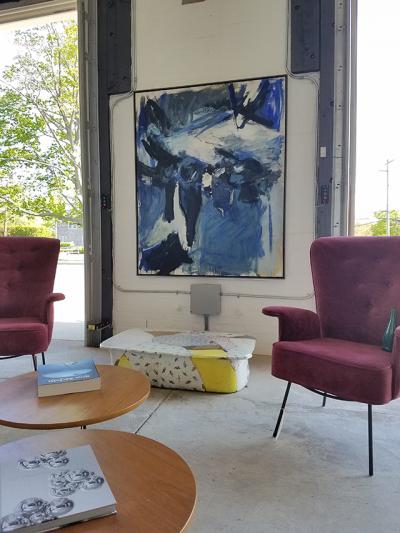Southampton Show Celebrates The ‘Organic Impulse’ in Art And Design

In the tidy brick building that once housed a Southampton Village power station, Jeff Lincoln has taken up residence with a gallery of visual and functional art. “The Organic Impulse in Contemporary Art and Design,” his current show, celebrates how artists and designers look to nature and organic shapes and motifs to inform their work in literal and more thematic ways.
Andrea Branzi’s aluminum bookcase is warmed with the addition of undulating birch branches, which are incorporated into the piece. Porky Hefer’s womb-like seating environments may be woven into a kind of hanging nest or structured into a cowhide conch-shaped shell. Each alien-like pod, looking like a plant from nature that might poison and then eat those who enter it, still attracts with its undulating primal design.
Many of the forms are bulbous, curvaceous, globular. When they are not — for example, Rick Owens’s “Stag Bench” — they include elements of nature such as a moose antler or the aforementioned white birch branches. Stefan Bishop’s console looks like a desert tree in its accretion of walnut slabs. Wendell Castle has a series of tables and chairs modeled after human teeth in a colorful, cartoonish way.
Joris Laarman is represented by a beautiful, kind of coppery bronze that looks like a low tree with a number of tree house platforms on it. Embellished with owl-like objects and a lacy nest/bowl that the artist designed, it is one show-stopping piece. Mr. Lincoln said its weight and the sharp angles of the shelves also made it a very perilous object to install. “My instructions to the crew were if anything happened, to let it go.” It could have taken someone’s leg or arm off otherwise. Knowing that such a graceful and beautiful object could be that dangerous adds to its allure.
In some areas of the space, or even in some individual works, it is hard to define where the functional gives way to the fine. A series of large wood sculptures by Raoul Hague are interspersed throughout the floor space. They suggest that they could be tables or seating, but are placed intentionally on pedestals. They magically meld with whatever objects Mr. Lincoln places near them, be they an Al Held painting, a John Chamberlain early metal sculpture, or paintings by Per Kirkeby.
Jack Youngerman’s floral abstractions meld with a chair, table, and lamps with plant-like motifs. A stool and lamp from the Haas Brothers could easily be branded sculpture, yet their descriptions include the words stool and lamp, evidence of a clear preference for the functional in their design. Some artists, such as Peter Lane, work across genres, making ceramic wall hangings that look like metal, and glazed stoneware that he forms into tabletops that look like marble sculpture.
None of it is too obvious or too pedantic. The objects and their groupings please the eyes before the brain can begin its analysis.
Some of the visual art choices might be too clever, but they are never too obvious. Lee Mullican is represented by colorful paintings that mimic wood grain. Georg Baselitz’s upside-down Morandi-esque “Still Life #2,” of a bottle and glasses on a table is a pleasant surprise, an abstraction that reveals its fitting subject slowly. The abstractions are soothing, if slightly decorative in this setting. Some paintings, like Eugene Leroy’s, seem almost sculptural with their thick impastoed buildup of paint.
The two connected rooms are full of light and space with garage doors that open out to the parking lot for air on cooler days. The pieces on display look completely at home in their early industrial setting, a testament to Mr. Lincoln’s background in interior design, which he continues to do while running this establishment. The show will be on view through July 31.
